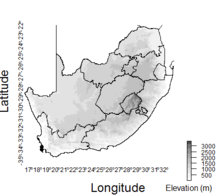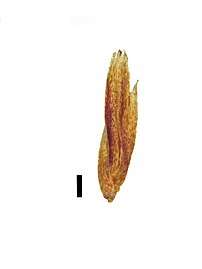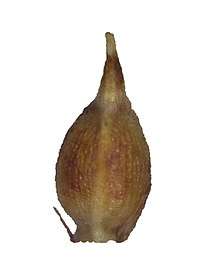Schoenus graminifolius
Schoenus graminifolius is a species of sedge endemic to the Cape Peninsula of South Africa.
| Schoenus graminifolius | |
|---|---|
| Scientific classification | |
| Kingdom: | Plantae |
| Clade: | Tracheophytes |
| Clade: | Angiosperms |
| Clade: | Monocots |
| Clade: | Commelinids |
| Order: | Poales |
| Family: | Cyperaceae |
| Genus: | Schoenus |
| Species: | S. graminifolius |
| Binomial name | |
| Schoenus graminifolius (Levyns) T.L.Elliott & Muasya | |
 | |
| Documented collection localities in South Africa | |
| Synonyms[1] | |
| |
Description
The main distinguishing characters of S. graminifolius are its papery (chartaceous) spikelet glumes that have reddish-purplish streaking throughout.[1] Another key character of S. graminifolius is that its lower primary inflorescence bracts are widened at the base.[1] Schoenus auritus also has lower primary inflorescence bracts that are widened at the base; however, that species has firmer glumes.
The basal leaves of S. graminifolius are usually relatively long and grass-like, so that they are almost as long or longer than the flowering stems.
Similar to other sedges, plants in this group are very difficult to identify. It appears that part of this problem is caused by the tendency of the southern African Schoenus to form hybrids with each other.[2] Schoenus graminifolius does not appear to form hybrids with other southern African Schoenus species.[1]
 Spikelet (the black scale bar represents 1 mm)
Spikelet (the black scale bar represents 1 mm) Nutlet
Nutlet
Taxonomy
Schoenus graminifolius is a species in family Cyperaceae, tribe Schoeneae.[1] Other notable genera in tribe Schoeneae include Lepidosperma, Oreobolus, Costularia, Tetraria and Gahnia.[1][3][4] The most closely related species to S. graminifolius are other southern African Schoenus species, specifically, species in the S. cuspidatus and allies group.[1]
Southern African Schoenus were once classified as Tetraria; however, based on molecular and morphological differences, we now know that the two groups are evolutionary distinct.[5] To ensure that this group of sedges is monophyletic (i.e. the genus only has closely related species), the southern African Tetraria were transferred into Schoenus.[5] In the field, the southern African Schoenus can be distinguished from Tetraria species by their lack of stem leaves and the absence of reticulate sheaths at the bases of the flowering stems.[5]
Distribution and habitat
Schoenus graminifolius has been found growing on granitic soils at elevations greater than 120 m.[1] To date, it is only known from the Cape Peninsula.[1]
Images
References
- Elliott, T.L.; Barrett, R.L.; Muasya, A.M. (2019). "A taxonomic revision of Schoenus cuspidatus and allies (Cyperaceae, tribe Schoeneae)—Part 1". South African Journal of Botany. 121: 519–535. doi:10.1016/j.sajb.2018.11.021.
- Levyns, M. (1947). "Tetraria and related genera, with special reference to the flora of the Cape Peninsula". Journal of South African Botany. 13: 73–93.
- Viljoen, J.-A.; Muasya, A.M.; Barrett, R.L.; Bruhl, J.J.; Gibbs, A.K.; Slingsby, J.A.; Wilson, K. L.; Verboom, G.A. (2013). "Radiation and repeated transoceanic dispersal of Schoeneae (Cyperaceae) through the southern hemisphere". American Journal of Botany. 100 (12): 2494–2508. doi:10.3732/ajb.1300105.
- Larridon, I.; Bauters, K.; Semmouri, I.; Viljoen, J.-A.; Prychid, C.J.; Muasya, A.M.; Bruhl, J.J.; Wilson, K.L.; Senterre, B.; Goetghebeur, P. (2018). "Molecular phylogenetics of the genus Costularia (Schoeneae, Cyperaceae) reveals multiple distinct evolutionary lineages". Molecular Phylogenetics and Evolution. 126: 196–209. doi:10.1016/j.ympev.2018.04.016.
- Elliott, T.L.; Muasya, A.M. (2017). "Taxonomic realignment in the southern African Tetraria (Cyperaceae, tribe Schoeneae; Schoenus clade)". South African Journal of Botany. 112: 354–360. doi:10.1016/j.sajb.2017.06.011.